Beneficial Bug Tub
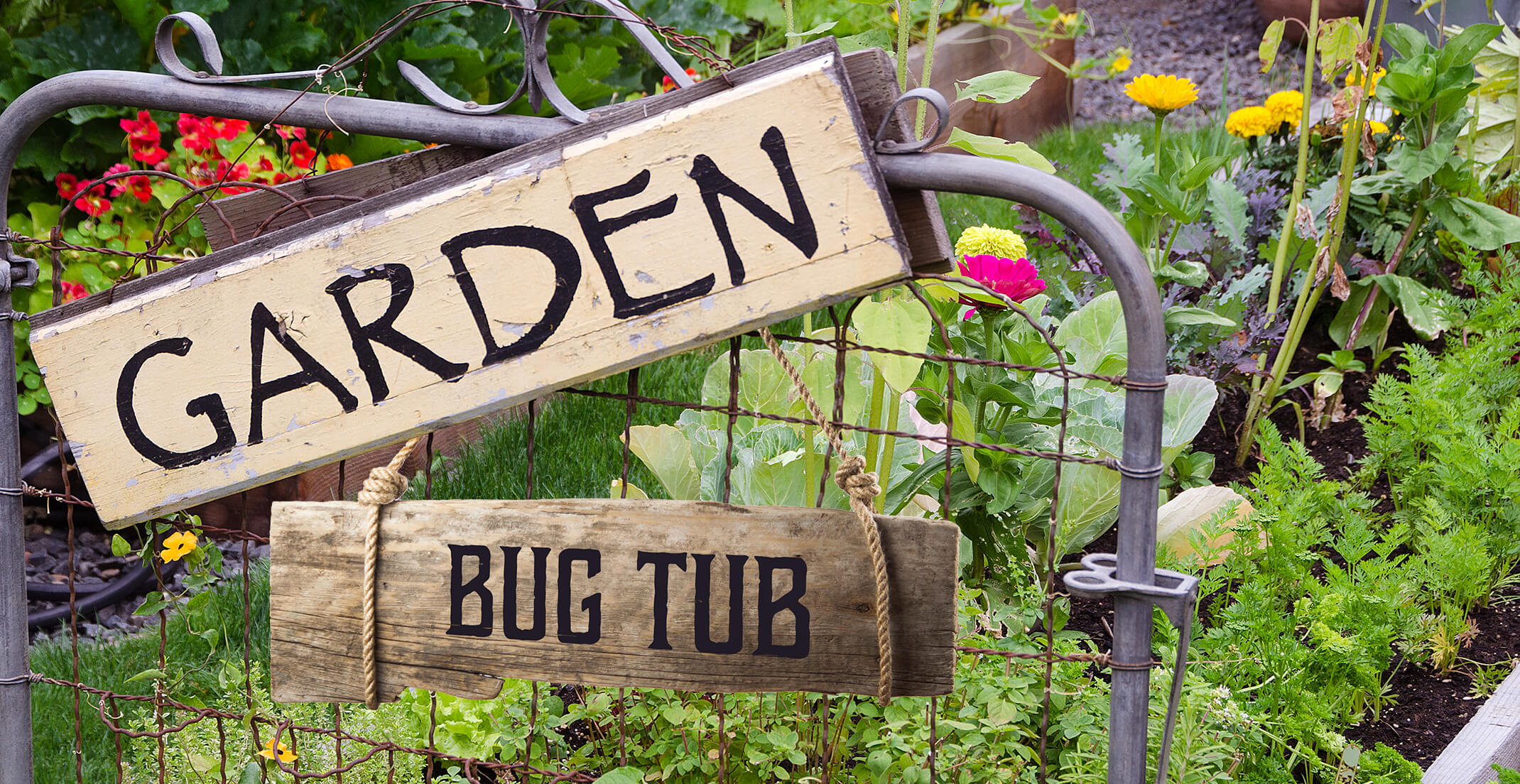
Good Bugs?
Yes, it is a bug-eat-bug world! Many “good bugs” can help manage pests that munch your prized plants. These helpful critters, either predators or parasites to the pests, can transform your garden into a self-regulating ecosystem, significantly reducing the need for pesticides. This not only paves the way for a dynamic and fascinating garden ecology but also means fewer pests to contend with. However, indiscriminate use of pesticides can eliminate these beneficial insects, leading to a rapid resurgence of pest populations without their natural checks.
Encouraging these advantageous insects to make your garden their home involves planting nectar and pollen-rich flowers. These plants provide essential sustenance for the beneficials, especially when their prey, the pests, are scarce. Whether you have a sprawling garden or just a modest collection of pots on your patio, adding a selection of these 'insectary' plants can make a significant difference. By integrating these plants among your garden's residents, you create a welcoming haven for these invaluable allies, ensuring they remain to patrol and protect your green space.
Making a Good Bug Tub
What kind of pot should I use? Ideally, you will want to have enough different plants for blooms throughout the year, but that could mean a big tub. Container size can also depend on weight limits on a balcony garden, the number and mature size of the plants you choose, and how often you want to water it. Perennials and shrubby plants need extra space. For shade-loving plants, a porous pot avoids moldy soil. Don’t forget drainage holes. To keep the pot out of water, set it on pebbles or other supports.
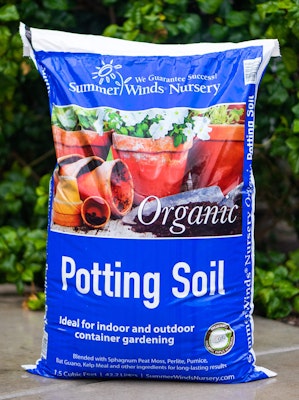 What kind of soil is best? A light, fast-draining soil is best for pots. Supplement commercial potting soil with compost and a bit of slow-release fertilizer (organic or pelleted). Fertilizer enhances plant strength and size, but too much fertilizer—especially for native plants—will favor leaves at the expense of flowers.
What kind of soil is best? A light, fast-draining soil is best for pots. Supplement commercial potting soil with compost and a bit of slow-release fertilizer (organic or pelleted). Fertilizer enhances plant strength and size, but too much fertilizer—especially for native plants—will favor leaves at the expense of flowers.
What’s special about container care? Group plants with like needs. Water pots more often and set them in slightly shadier spots than similar in-ground plantings. Mulch on top (leaves or compost) can keep pots from drying out too fast and provide shelter for insects. For early bloom, plant the pot with wildflower seeds in fall.
What beneficial insects can I attract? Ladybugs, properly “ladybird beetles,” are the best-known beneficials, but most people don’t recognize their alligator-shaped larvae—even better predators than the adults—or their orange eggs on the bottom of leaves. Likewise, lacewing and hover fly larvae are the predaceous stage. And there are many more beneficials, including parasitic wasps—happily, much too small to sting—and soldier bugs, armored like six-legged tanks. Guides such as “Mac’s Field Guide: Good [and Bad] Garden Bugs of California” (a laminated sheet) and Starcher’s charming Good Bugs for Your Garden can introduce these tiny neighbors.

A Good Bug Tub Recipe:
- Blue bedder penstemon (Penstemon heterophyllus var. purdyii); perennial, blooms June–July
- California poppy (Eschscholzia californica); perennial, March–October; long tap root requires tall pot
- Dwarf blue lupine (Lupinus nanus); annual, March–May; can add seeds in fall
- Seaside daisy (Erigeron glaucus); perennial; March/April–August
- Coyote mint (Monardella villosa); perennial, May–September
- Common yarrow (Achillea millefolium); perennial, April–July
- Tidy tips (Layia platyglossa); annual, March–September; add seeds in fall
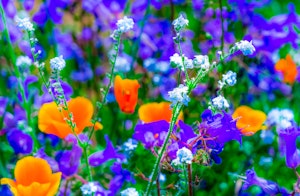

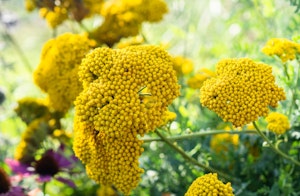
More Good Insectary Plants for Containers
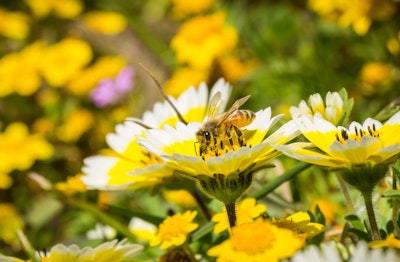
Plan for diversity. One of every five flowering plant species is attractive to beneficials. Look for flat or shallowthroated flowers sized to the tiny mouthparts of beneficials and rich with nectar and pollen. Carrot relatives (many herbs) are top nectar producers; note they must flower to be insect food. Sunflower relatives (think daisy form) bloom longer. The small flowers at the center are surrounded by ray flowers with their petal landing pads. For early bloom, many species can be seeded in fall.
Insectary Plant Examples
| Variety | Need/Type | Performs |
|---|---|---|
| Aster | Sun; More Water; Perennial | Some native. Choose short species for pots. Bloom summer–fall. |
| Baby blue eyes (Nemophila menziessii) | Sun to Part Shade; More Water | Native. Trailing. Blooms Feb.–April. |
| Buckwheat (Eriogonum) | Sun; Perennial | Native. Resist drought. Gravelly soil, require excellent drainage. Sulphur & red buckwheats easier. Some bloom to Dec. |
| Chrysanthemums, marguerites, feverfew, daisies | Varies | Golden marguerite attracts all five major groups of beneficials. |
| Coreopsis | Sun; More Water | Some native. Deadhead for long season. |
| Cosmos | Sun; Annual | Select dwarf strains for pots. Bloom summer–fall. |
| Fleabane (Erigeron) | Sun; More Water; Perennial | Native. Blooms April–June/July. |
| Goldenrod | Sun to Part Shade; Perennial | Some native. Look for smaller ones. |
| Herbs/vegetables: cilantro/coriander, parsley, caraway, thyme, borage, carrots, small mustards, chamomile, basil, tansy, rosemary, dill (tall), others | Varies | Cilantro and African blue basil highly recommended. Prostrate rosemary trails over edge of pots. Let some herbs flower and some carrots and parsley winter over. |
| Mints: spearmint, peppermint, catnip (Dropmore), lemon balm, Korean mint, others | More Water; Perennial | Some native. Lemon balm blooms July–Oct. Good shelter. |
| Monkey flower (Mimulus) | Perennial | Native. Scarlet monkey flower smaller than sticky monkey flower but needs more shade and water. Scarlet: Bl. June–July. |
| Queen Anne’s lace (Daucus carota) | Sun; Biennial | Tall. Blooms May–Sept./Oct. |
| Rudbeckia (coneflower, black-eyed susan) | Sun; More Water; Biennial and Perennial | Some native; vary in height. |
| Sunflower (Helianthus), Mexican sunflower (Tithonia) | Sun; Annual | Pick dwarfs for pots. Avoid those with pollen drop bred out. |
| Sweet alyssum (Lobularia maritima) | Sun; Annual | Highly recommended. Blooms all seasons. |
| Verbena | Sun; Perennial | Some native. Give lots of sun and heat, no water on foliage. |
| Yarrow (Achillea) | Sun; Perennial | Highly recommended. Some native. Insects like white. May-Jul. |
Sources
Bauer, N. The Habitat Garden Book: Wildlife Landscaping for the San Francisco Bay Region, 2001. Flora for Fauna: Habitat Plants for Birds, Butterflies, and Beneficial Insects. “Gardening for Wildlife with Native Plants,” Bay Nature Supplement, Jan.-Mar. 2003.www.ipm.ucdavis.edu. (University of California Integrated Pest Management site: pest identification, IPM approach)
www.cnps-scv.org (a local California Native Plant Society chapter site; see “Gardening with Native Plants”)
http://www.laspilitas.com/ (database of California native plants with photos, range, cultural information; more)
Regional Water Quality Control Plant www.cityofpaloalto.org Operated by the City of Palo Alto for the East Palo Alto Sanitary District, Los Altos, Los Altos Hills, Mountain View, Palo Alto, and Stanford

